Working “Up North”
Drawn to the Canadian backcountry while measuring Earth’s magnetic field
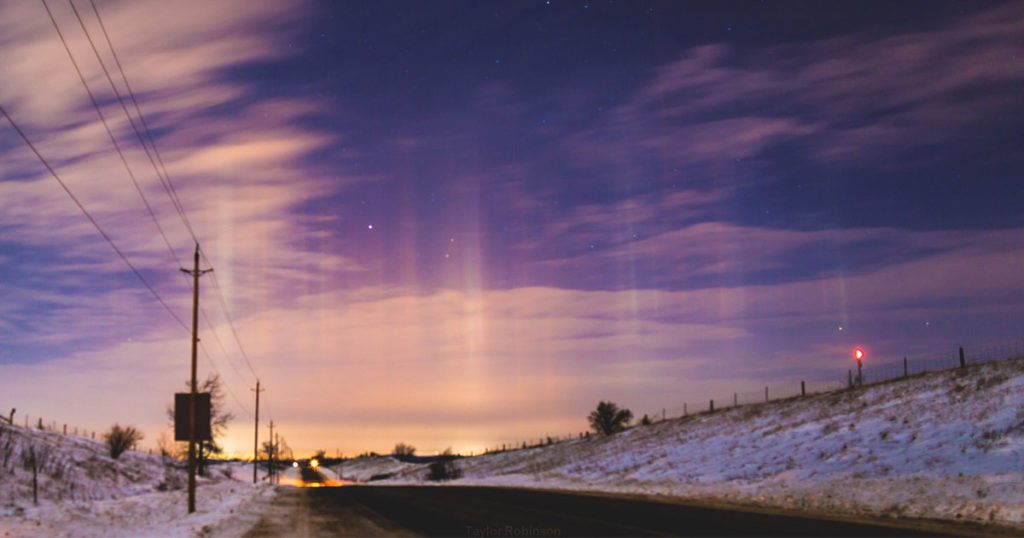
When I was a physics undergraduate at the University of Toronto, during and shortly after the Second World War, it was customary for students to take a job during the long summer vacation. A good summer job could earn a frugal student enough money to cover the cost of tuition ($200 per year) and living expenses in the coming term. The weekly rent for a shared attic room was $5, a can of sweet peas cost nine cents, and a piece of raisin pie, a rare treat, was a dime.
My most interesting summer jobs took me to the “bush country,” the vast boreal forest that covers northern Ontario and Quebec and extends all the way to Siberia. The region is dotted with innumerable lakes left behind when the glacier that covered much of North America retreated some 10,000 years ago. In the 1940s, only a few roads cut through its dense, blackfly-infested forests, connecting the lumber camps, the gold and copper mines, and the sparse towns. These dirt and gravel roads included numerous bumpy “corduroy” sections of logs laid crosswise that presented a challenge to drivers and vehicles alike. Once, I bottomed my Plymouth so hard that the crankcase sprang a leak and the engine lost oil pressure. I limped into a fortuitously nearby lumber camp, where I used my primitive French to explain my predicament to a group of lumbermen. They counseled me to go to their canteen, buy several sticks of chewing gum, and chew them for half an hour. I heeded their advice and used the gum to mend the leaking crankcase. The fix, by the way, held fast until I returned to Ottawa, hundreds of miles later.
The inhabitants of this region, known to Torontonians simply as “up north,” were persuaded that if you remained there for any length of time, you were bound to become “bush-whacky”—and I have no reason to doubt them. Apart from the townsfolk, miners, and lumbermen who lived there, a goodly number of prospectors roamed the bush country, each of them hoping to discover a rich gold-bearing vein in one of the countless rock outcroppings that dotted the landscape, and to stake a claim for the mineral rights. Few of their duly registered claims turned out to be exploitable, because they were too far from a road—but hope springs eternal in every prospector’s breast.
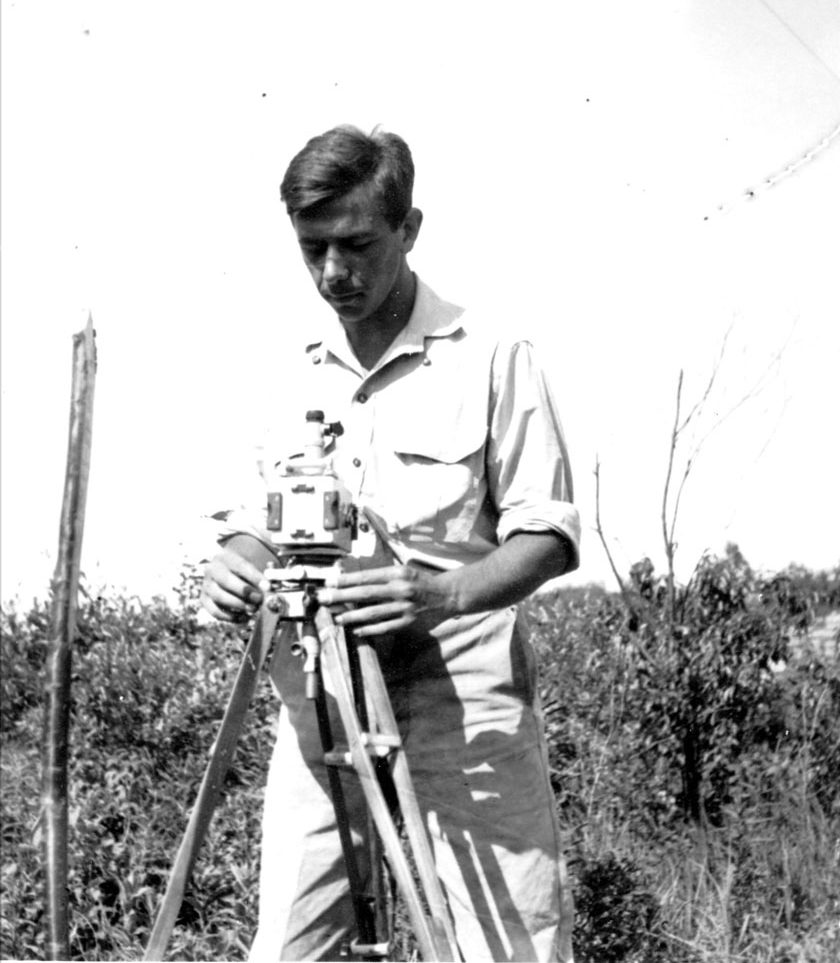
The author at work
Both of my summer jobs up north involved the Earth’s magnetic field. In the first, I worked for Hans Lundberg, a Swedish-Canadian geophysicist, who gave me the task of mapping the variations of the magnetic field within a claim area whose commercial potential his firm had been engaged to evaluate. I worked alongside an experienced geologist who scrutinized the claim’s granite outcroppings, and by combining the magnetic and geological information, Mr. Lundberg was able to trace geological formations beneath the overburden and to identify faults—the likely sites of mineral deposits. I measured the field with a sensitive Schmidt magnetometer (long since superseded by electronic instruments) at an array of stations, 25 feet apart, each marked by a wooden stake. This grid was constructed by local workmen who cut straight, parallel lanes through the bush. The men were paid their wages each Saturday at noon, and they returned to work only after running out of money or liquor.
When one claim that we surveyed was too far from the nearest town to make commuting practical, we bunked instead in a shack on our work site. Instead of living on cans of pork and beans, my savvy geologist partner arranged for the wife of a French-Canadian trapper to provide us with breakfast and dinner while her husband was away tending his traps. Since her log cabin stood on the opposite bank of a sizable lake, we were obliged to paddle our canoe across the lake twice a day, in fair weather or foul, in order to enjoy her conversation and her splendid cooking. She spoke not one word of English and took evident pleasure in teaching me French, while giving me a taste of life in colonial times. It made me feel like a real Canadian.
Once we finished surveying the claim, we made contour maps showing its geological and magnetic field features. We then headed for the nearest town that possessed a hotel and had telephone service. We called Mr. Lundberg in Toronto, and he arrived the next morning by seaplane, landing on a nearby lake. We met him at the dock and drove to our hotel, a wood building that thoughtfully provided guests with a coiled rope under each window, in case of fire. I was particularly taken by the nickelodeon in the hotel lobby: it had a six-inch screen and for a nickel you could watch a sparsely dressed lady dancing for one minute. Mr. Lundberg ordered two bottles of whiskey and mounted our maps on the walls of his hotel room. He studied them intently, a glass of whiskey in his hand, and marked the most promising test drilling sites with red X’s. His work done, the three of us descended into the dining room for a meal of steak and potatoes.
Mr. Lundberg had developed a flawless, albeit dubious, business model. The claim’s corporate owners would pay him a fee for evaluating its mining potential, and as soon as his report was published in The Northern Miner, it had a dramatic effect on the company’s share price. Before submitting a very favorable report, Mr. Lundberg acquired some of the company’s shares, known as penny stocks, and sold them at a profit after his report was published. At the end of the summer, Mr. Lundberg was so pleased with my work that he urged me not to return to the university, but to work with him. He promised to make me a millionaire within one year, and knowing his modus operandi, I had no reason to doubt him. I had, however, had my fill of life up north and was not tempted by his offer. The following year, Mr. Lundberg was the first person to use a helicopter for his magnetic surveys, and he soon attained fame as the “Canadian treasure hunter.” Ever flamboyant, he also teamed up with an archaeological excavation expedition in Mexico, located mineral deposits in Africa by analyzing the plants growing in the vicinity, and was decorated by the King of Sweden.
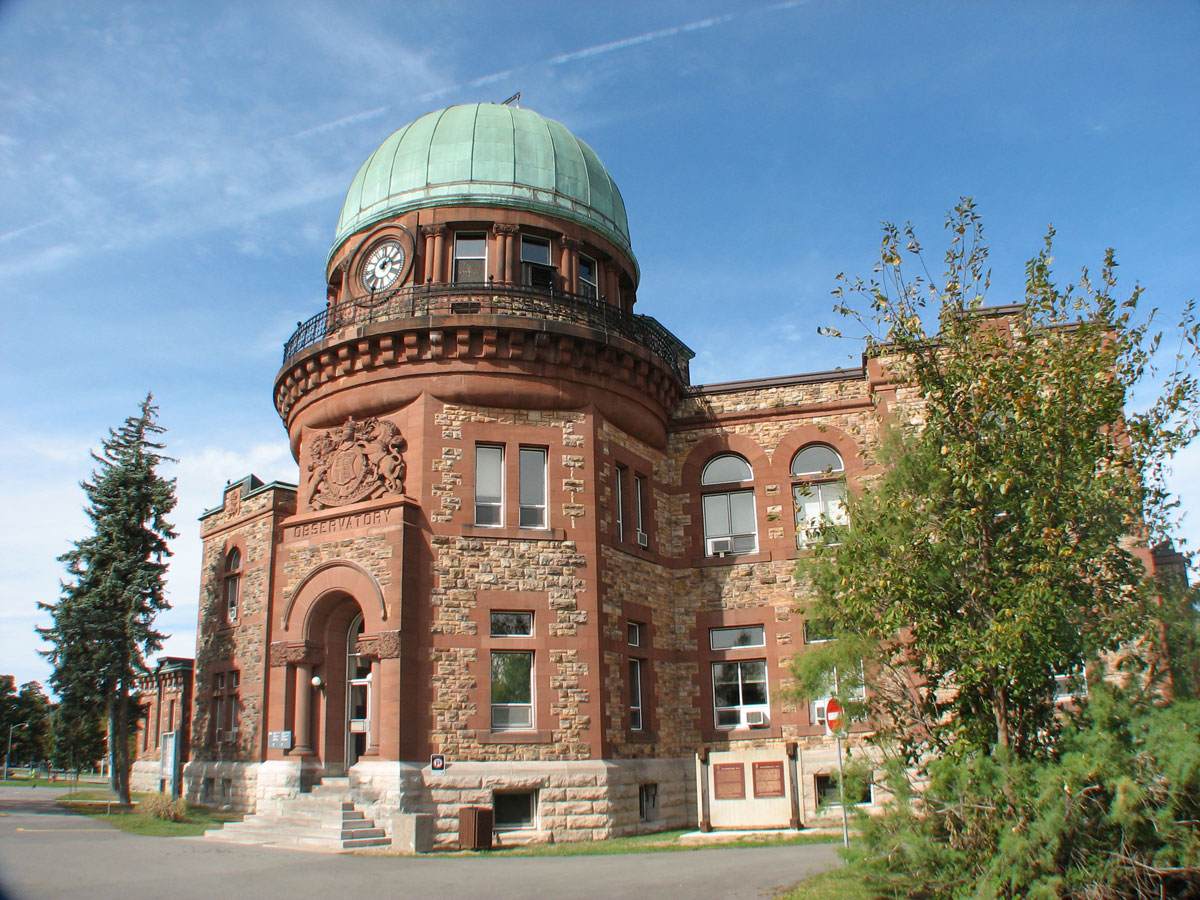
The Dominion Observatory in Ottawa (Wikimedia Commons)
Following my military service, I returned to the university. The next summer, I was lucky enough to get a job with the Terrestrial Magnetism Division of the Dominion Observatory. I joined its staff of a dozen dedicated scientists whose mission was to keep track of the meanderings of the Earth’s magnetic field. The Earth’s field is created by the slow viscous motion of its liquid outer core, mostly molten iron and nickel. Its slow turbulence caused the magnetic North Pole, then near Canada’s Baffin Island, to move to a location near the geographical North Pole. We were housed in this charming 19th-century observatory, along with its resident astronomers, who provided Canadians with the exact time by radio each noon, among their other astronomical missions.
Most people pay little attention to the magnetic field that envelopes our planet, even though the field plays the vital role of protecting us from the dangerous charged particles that shower Earth from the sun and outer space. The observatory’s Magnetic Division monitored the strength and direction of the magnetic field all over Canada and, to this end, a network of fixed magnetic stations had been established in all provinces. Each station consisted of a bronze benchmark cemented into solid rock, marking the exact spot where the field was measured every few years. Today, the field is monitored continually by a network of automated instruments that require little human intervention.
Back then, I was given the task of visiting established magnetic stations in eastern Quebec in order to make fresh observations. I was provided with an official car, a French-Canadian student-assistant, along with a tent, a short-wave radio, a chronometer, a telescope with a tripod, and the delicate instruments used to measure the strength and direction of the magnetic field. Nowadays, these beautiful, handcrafted instruments are archaic and can only be found in science museums and antiques shops.
The magnetic stations were usually located on public land, such as the grounds of a lighthouse, or on a reservation of indigenous Canadians. I visited one such isolated reservation on the north shore of the St. Lawrence, where the river is many miles wide. I was welcomed by the keeper of the communal icehouse and his wife, who were as curious about my purpose in coming as I was about their way of life. I learned that the settlement’s members lived primarily on salmon caught in their tidal nets and on the game they managed to hunt. At the behest of the local priest, the women of the settlement had learned to raise and eat vegetables, but the men eschewed such “rabbit food.” After I explained that I was looking for the bronze marker that had been left some years before, the men offered to help me find it. Sometime later, one of them returned, lugging a boulder with the marker embedded in it! I kept a straight face and thanked him for his help. Here, as in other communities I visited, the locals treated me very hospitably; they lived such insular lives that a visit by a stranger, for whatever reason, was a welcome crack in their isolation. At a lighthouse site on the Gaspé coast, I once invited a group of schoolchildren whose teacher had spotted me, to come after dark in order to observe the mountains on the moon through my telescope, and their utter astonishment was hard for me to believe.
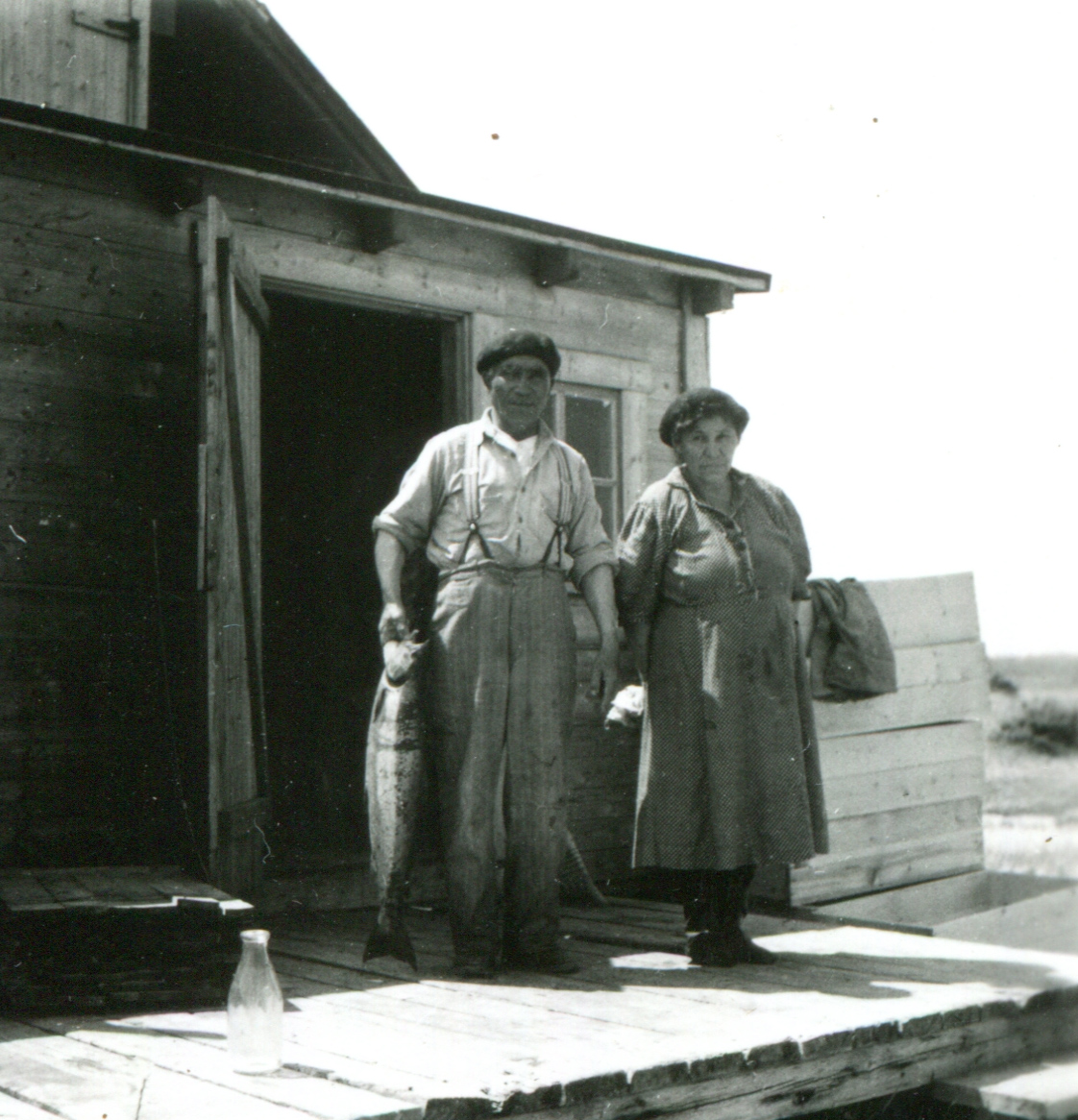
The icehouse keeper and his wife
When it became practical to establish a new magnetic station in a region of Quebec that had previously been inaccessible to cars, I was given another opportunity to spend time up north. Near the town of Chibougamau, sizable gold and copper deposits had been discovered that were promising enough to warrant constructing a 200-mile road to connect Chibougamau to Roberval, a port town on Lac St. Jean, the headwater of the mighty Saguenay River. Because that tributary of the St. Lawrence follows a fault line, it is of prodigious depth and is navigable by seagoing ships. My assistant and I drove to Roberval, and since we were among the first to venture on the barely finished dirt road, I thought it wise to inquire if accommodations were available in Chibougamau. I was relieved to learn that the town, indeed, boasted a hotel.
We reached Chibougamau well after dark, amidst a driving rainstorm. The town, we discovered, consisted of a couple of dozen log cabins scattered in the woods, each surrounded by a banked-up mound of empty cans and bottles. We had no problem finding the hotel, the town’s only two-story structure, but when I asked about a room for the night, I was told that the establishment had only a single room for rent, and it was continually rented by the resident prostitute. She occupied the room for a week, and each Saturday her replacement arrived by seaplane from Montreal and took up residence in it.
Downstairs in the hotel was a tavern that offered just two items for sale: beer at $1 and whiskey at $10 a bottle—outlandishly high prices at that time. We two sat at a table and contemplated spending the stormy night in our Plymouth sedan, when a patron came by and pointed out to me a gentleman sitting alone at a table, his brooding face enveloped in an imposing thick, black beard. That, I was told, is Chibougamau Joe, and for the price of a few beers he would most likely let us bunk in his cabin. I approached Chibougamau Joe, who turned out to be a man of few words, and he quickly agreed to my proposition. We parked our car and he led us, in the dark, to his shack in the woods. He indicated a double-decker bunk bed in which my helper and I slept soundly for the remainder of the stormy night.
We woke to brilliant sunshine and drove along the road leading to a mine under construction, in search of a suitable site for the new magnetic station. We soon found an excellent spot on an outcrop, well off the road and close to the shore of a lovely, pristine lake. The lake turned out to be teeming with northern pike, for when I, a thoroughly inexperienced angler, tossed a line into the lake, a pike would be dangling from it within a minute. We were busy setting up the tent and unpacking our instruments when an engineer from the nearby mine came to see what we were up to. I explained our mission, and he asked if we had found a place to stay. I told him who we were bunking with, whereupon he commented that he did not know that Chibougamau Joe was back. I said that I was unaware he had been away and was told that Joe had been in prison for murdering his cabin mate. That must have startled me, for the engineer now kindly offered to let us stay in a wood hut with simple sleeping accommodations that the mine used for its visitors, and I accepted with alacrity. We retrieved our few belongings from Chibougamau Joe’s cabin, and I left a note explaining our departure.
A week later, after we had meticulously characterized the Earth’s magnetic field in Chibougamau, my helper and I headed back to the relative luxury of a hotel in Roberval. Walking along the hotel corridor, I was somewhat taken aback to encounter the unambiguously bearded Chibougamau Joe! We exchanged greetings, and I told him I was sorry about moving out of his cabin without saying goodbye, and he nodded silently.
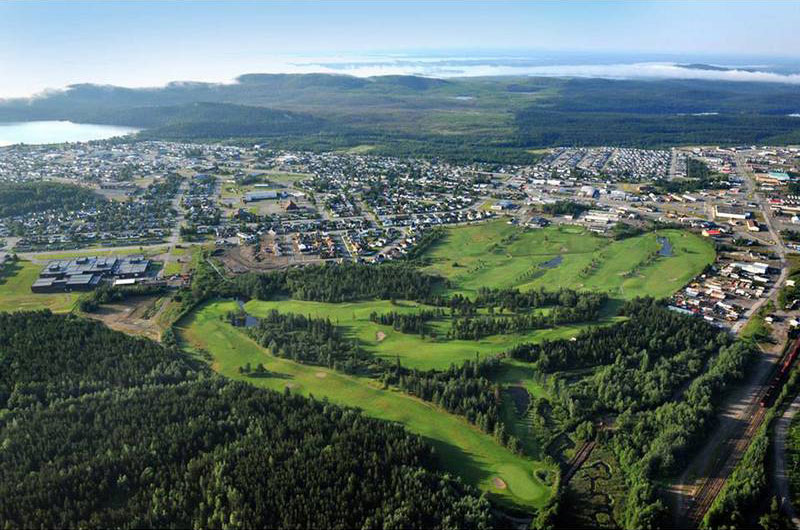
Club de golf de Chibougamau-Chapais
Today Chibougamau is a mining and lumbering hub with 8,000 inhabitants, four hotels, and a club de golf.

